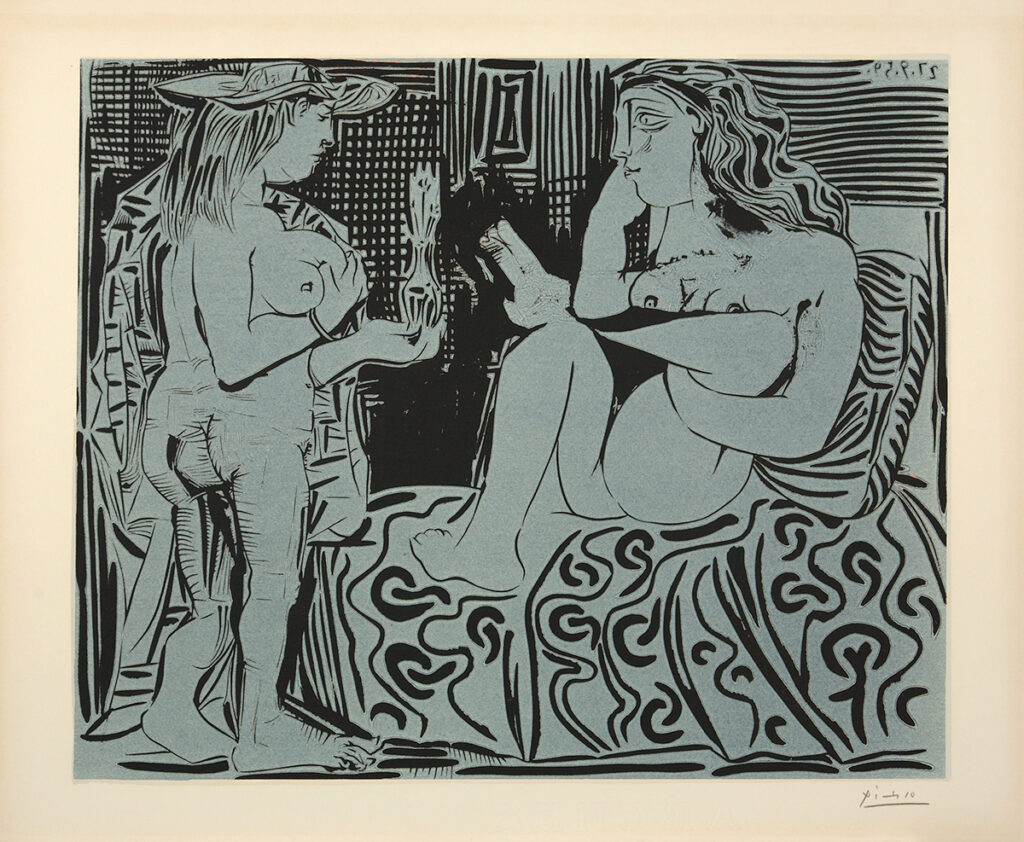
In 1933, Picasso divulged one of his many philosophies on inspiration to his friend Zervos: “We must pick out what is good for us where we can find it…” The artist was a true sponge, something the preceding quote proves he was proud to admit. It was a technique, not a crutch. Besides innate artistic talent, Picasso’s most genius quality was perhaps his ability to learn from the old masters without copying; instead, he absorbed them into his own creative psyche, thereby allowing him to translate these scenes into his own modern language.
Picasso had a life-long fascination with Manet, whose odalisque masterpiece Olympia (1814) serve as inspiration for B915. One of the most boundary-pushing Post-Impressionists, Manet’s unapologetic portrayals of Parisian society shocked salon audiences and Olympia was no exception. As Picasso’s career snowballed into stardom, his admiration for artists like Manet turned into competition, fueling a determination to create his own versions of canonical masterpieces.
Today’s print mirrors Olympia’s combination of a nude figure laying on a chaise lounge and a lady-in-waiting of some sort bringing her flowers. In Manet’s painting, the odalisque is completely nude save for some slippers and various adornments around her head, neck, and wrist. She looks directly at the viewer, implicating them in the scene as a visitor to her chambers. Her appearance and beckoning gaze act as 19th-century clues that we are looking at a brothel. Though Picasso kept the basic idea of the source material, his competitive and innovative nature emerged in his playful approach to the perspective. In B915, the figures are turned in toward each other, seemingly unaware of our presence. Where Manet slightly distorted naturalist conventions of space, Picasso threw conventionality away almost completely and transformed the scene from real to surreal.
By changing the viewer’s relationship to the scene, Picasso also highlights his changes to the odalisque’s serpentine shape. Instead of appearing as a long fluid line on the chaise, she appears more rectangular, folded up into a variety of shapes. The importance of shape is further emphasized by the high volume of texture and pattern before us. B915 is a linocut, created by carving a design into a linoleum block, stamping each layer at a time to create the desired effect. Picasso marks another departure from his predecessors by filling any negative space with stripes, swirls, crosshatching, and more. This continues to further us away from any reality Ingres or Manet might have grounded their viewers in by recessing the background into the shadows of an otherwise imagined room. Picasso, on the other hand, reimagines us into a flat but vibrant world where no centimeter is left un-designed.
This print not only demonstrates Picasso’s mastery of printmaking techniques and thorough knowledge of his artistic lineage but more so provides a surreal sensory experience for the viewer that only a 20th-century person could dream up. In other words, he “recreated the past as a living present.” As mentioned, both odalisque paintings today’s print was modeled after shocked their contemporary audiences, especially Manet’s, with overt nudity and the suggestion of prostitution. But over time, thanks to artists’ pushing of social boundaries, norms evolve to the point that was once scandalous or disorienting doesn’t seem so at all. It’s at precisely this philosophical juncture that Picasso situated himself. Aware of the artist’s crucial socio-cultural role to pull us away from what is comfortable, he created images, like today’s print, that are both familiar and unfamiliar, disrupting the mundanity of life and giving us a moment to be curious.
Courtesy of John Szoke Gallery, New York.
